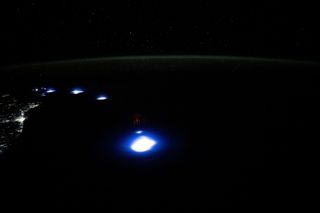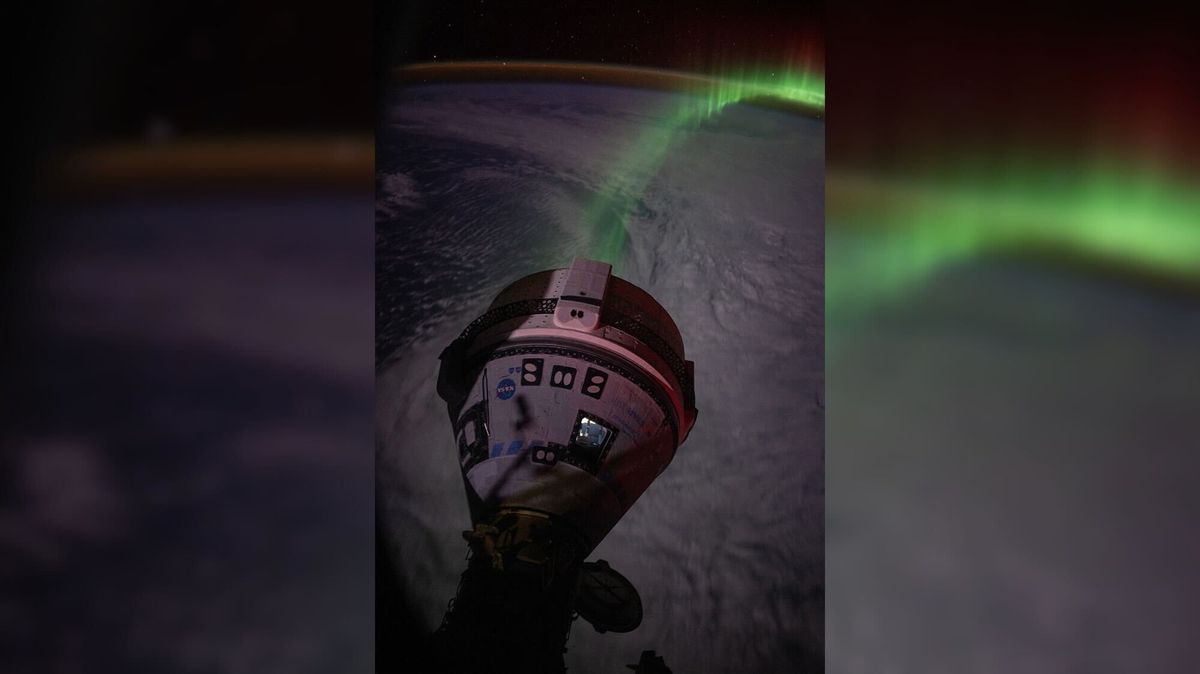The view from Earth looking up at the stars is an incredible one, but a select few have the chance to look down at their home planet from space and capture the incredible scenery on camera.
A recent X Spaces (formerly Twitter Spaces) event featured NASA astronauts Matthew Dominick and Don Pettit revealing the secrets of doing astrophotography from low Earth orbit.
Dominick, who is currently on board the International Space Station (ISS) as part of Expedition 71, and Pettit, who will launch to the orbiting outpost in September, passed on their astrophotographic know-how, describing how they take incredible images of Earth, the atmosphere and the stars from their perch 200 to 250 miles (320 to 400 kilometers) above the surface.
“It’s just an incredible view out the window,” said Dominick during the NASA-hosted event. “And I realize that so many people are fascinated by the pictures that we get to take up here.”
Related: International Space Station: Everything you need to know about the orbital laboratory
Photography is actually a significant part of an astronaut’s role on board the ISS, documenting the planet far below. NASA astronauts are trained in the use of a camera at Johnson Space Center in Houston. And Dominick, who launched to the ISS on March 4 as commander of the SpaceX Crew-8 mission, reckons that he has snapped between 150,000 and 200,000 images during his time in space. He has also filmed a short video showing how some of the amazing photographs are taken.
It’s not as simple as pointing the camera out through the window, said Pettit. For one thing, the ISS is traveling at about 17,500 mph (28,000 kph), meaning that a timed exposure will blur the features of Earth.
The other problem is the stars. On Earth, our planet’s rotation turns the stars into long streaks that circle around the pole unless one uses an equatorial mount with a motor drive to track the stars as they move from our perspective in the sky. Because the ISS is not on Earth, it doesn’t have to worry about our planet’s spin. But there’s a different problem as the station moves around the planet.
“It’s hard to keep the stars as pinpoints in exposures greater than a quarter, or maybe half, a second,” said Pettit. “This is just because of the pitch rate of the station, and it makes the stars trail instead of appearing as points. You just can’t do a long time exposure.”
However, Pettit — whose interest in photography began as a child, inspired by his mother, who was a freelance photographer for several magazines — has a few tricks up his sleeve. When he launches for the ISS in September, among his personal belongings will be a small device that, when wound up, moves at one revolution per 90 minutes (the time it takes for the ISS to complete one orbit of Earth).
“It’s basically a space station sidereal drive that matches the pitch rate of the station, and I can speed it up and slow it down about plus or minus 10%, and I’m hoping to use this to get time exposures of the stars of 30 seconds to one minute long,” said Pettit. These exposures could then be stacked in image processing software to get what Pettit hopes will be “really spectacular star-field pictures, particularly ones that show the color of the stars that you can see with your eye.”
Pettit ran through the camera equipment that has been used by astronauts on the ISS over the years.
“For digital still cameras, we have always used the top-of-the-line Nikon cameras,” he said. “On my first mission [in 2002], it was a Kodak Nikon 760, which is a high-quality, professional-level camera that used a Kodak chip. And then for my second mission [in 2008], we were using Nikon D2X cameras, and then for my third mission [in 2011], it was Nikon D3S cameras. And now we have the Nikon Z9 and the D5 on station. We will also soon have a 14mm f/1.4 wide-angle lens and a 15mm prime cinema T1.8 lens, both adapted to the Z9. I’m really hoping that these two lenses will allow wide-field astrophotography in a way that we’ve never been able to do before.”
Related: The top 10 views of Earth from space
With all this top-of-the-line camera kit, what are the two astronauts’ favorite images that they’ve shot in space? For Dominick, one of his favorites was completely down to good luck.
“One day, [Boeing‘s] Starliner was in front of the station, and they were going to do some hot-fire testing, and the flight director called me and asked if I could take some video of that,” he recalled. “It just so happened that we were going over Antarctica, and the aurora was right there — one stream of green aurora that I could tell it was marching toward Starliner and it would look like this green aurora was coming out of Starliner. I was so excited; I knew I had to take the picture. Luckily, I had been taking a lot of nighttime photos of aurora, so I knew roughly what settings to start with.”
Pettit’s favorite photograph came early in his astronaut career, back in 2003, and took advantage of those usually inconvenient star trails. In fact, it was so long ago, it wasn’t even taken with a digital camera!
“It was taken on Fujichrome 100 film [which Pettit got special permission to take to the ISS because of its nighttime sensitivity], and it was a 15-20 minute exposure, and it shows cities streaking by. It shows several regions in the atmosphere, the lower region up to about 120 kilometers [75 miles] and going up into the F-region [the highest part of the ionosphere] which is like 300 to 600 kilometers [186 to 373 miles], which is the region the space station orbits in,” he said.
The 2003 image also captures the clumsier way in which the space station used to alter its pitch, resulting in the trails all having a slight jerk as the station lurched. “They didn’t have the algorithms for controlling the space station’s attitude as well honed in 2003 as they do now,” said Pettit. “But this picture shows so much physics, so much natural phenomena.”
Sometimes though, an astronaut just has to put their camera down, watch as a spectacle unfolds before them and appreciate how fortunate they are to be in such a privileged position to witness such events. Dominick remembers a time when the ISS was passing over the coast of South Africa, where a huge thunderstorm was erupting.
“We saw the most intense lightning from the station’s cupola,” he said. “I grabbed for the camera to take a picture, trying to figure out how to get a time-lapse out of it, and I just stopped because I knew I wasn’t going to get it set up in time and I would miss the moment and not live in it. I think sometimes it’s just good to put the camera down.”
Ninety minutes later, the ISS was back over South Africa, and Dominick was ready with his camera. The storm had waned quite a bit by then, but he took his time-lapse image anyway. ISS astronauts take so many photos that they don’t have time to check through them all, but they all get uploaded onto the internet for anyone to look at. Dominick was soon contacted via social media by someone who had been looking at his time-exposure of the South African thunderstorm and had spotted something: a red sprite.
Related: Sprites from space! Astronaut photographs rare red lightning phenomenon from ISS

Sprites are a phenomenon associated with thunderstorms, specifically electrical discharges that point upward from thunderclouds, rising high into the sky. For a century, recorded sightings of sprites had been rare, until they were first captured on camera in 1989. Since then, they’ve been photographed more often from aircraft and from space. But sprites are so short-lived that often even astronauts, looking down on the cumulonimbus clouds of thunderstorms, don’t always see them in real time, and only notice them after the fact when looking through their images.
“It’s amazing how often you can see a sprite on top of a thunderstorm in an image that you never had a chance to see when you were there,” said Pettit.
Photography from the space station has obvious scientific benefits, such as the snaps of sprites. What Dominick and Pettit enjoy the most, though, is being able to share their images with the public.
“One of the pure joys I get out of doing astrophotography from the space station is the ability to share, through imagery, what we as astronauts get to see,” said Pettit. “It’s not exactly the same, though, as the color, the dynamics, cannot be recorded yet with still imagery to the same level as what you see with your eyeballs.”
It’s this quest to try to document life on the ISS, and the view through the windows, with as much accuracy and clarity as the astronauts themselves experience, that’s driving Dominick’s own photography.
“When you arrive in orbit and you take that first look out of the window — I’ve spent the rest of the mission trying to figure out how to capture that, to capture what my eyeballs see, the dramatic dynamic range we have up here, the transitions from day to night,” he said. “I’ve yet to completely capture with a camera the things that I am seeing with my eyes, but I feel an obligation to do it. I feel I need to share the experience that I have up here.”
And you can share in that experience by following the astronauts on their Instagram feeds. Matthew Dominick’s can be found here, and Don Pettit’s is here. You can also find images on NASA’s Gateway to Astronaut Photography of Earth.

















.png)


Discussion about this post